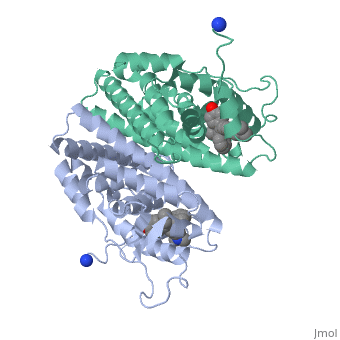3ert
From Proteopedia
(Difference between revisions)
| Line 1: | Line 1: | ||
==HUMAN ESTROGEN RECEPTOR ALPHA LIGAND-BINDING DOMAIN IN COMPLEX WITH 4-HYDROXYTAMOXIFEN== | ==HUMAN ESTROGEN RECEPTOR ALPHA LIGAND-BINDING DOMAIN IN COMPLEX WITH 4-HYDROXYTAMOXIFEN== | ||
| - | <StructureSection load='3ert' size='340' side='right' caption='[[3ert]], [[Resolution|resolution]] 1.90Å' scene=''> | + | <StructureSection load='3ert' size='340' side='right'caption='[[3ert]], [[Resolution|resolution]] 1.90Å' scene=''> |
== Structural highlights == | == Structural highlights == | ||
| - | <table><tr><td colspan='2'>[[3ert]] is a 1 chain structure with sequence from [ | + | <table><tr><td colspan='2'>[[3ert]] is a 1 chain structure with sequence from [https://en.wikipedia.org/wiki/Human Human]. This structure supersedes the now removed PDB entry [http://oca.weizmann.ac.il/oca-bin/send-pdb?obs=1&id=2ert 2ert]. The September 2003 RCSB PDB [https://pdb.rcsb.org/pdb/static.do?p=education_discussion/molecule_of_the_month/index.html Molecule of the Month] feature on ''Estrogen Receptor'' by David S. Goodsell is [https://dx.doi.org/10.2210/rcsb_pdb/mom_2003_9 10.2210/rcsb_pdb/mom_2003_9]. Full crystallographic information is available from [http://oca.weizmann.ac.il/oca-bin/ocashort?id=3ERT OCA]. For a <b>guided tour on the structure components</b> use [https://proteopedia.org/fgij/fg.htm?mol=3ERT FirstGlance]. <br> |
| - | </td></tr><tr id='ligand'><td class="sblockLbl"><b>[[Ligand|Ligands:]]</b></td><td class="sblockDat"><scene name='pdbligand=OHT:4-HYDROXYTAMOXIFEN'>OHT</scene></td></tr> | + | </td></tr><tr id='ligand'><td class="sblockLbl"><b>[[Ligand|Ligands:]]</b></td><td class="sblockDat" id="ligandDat"><scene name='pdbligand=OHT:4-HYDROXYTAMOXIFEN'>OHT</scene></td></tr> |
| - | <tr id='gene'><td class="sblockLbl"><b>[[Gene|Gene:]]</b></td><td class="sblockDat">ESTROGEN RECEPTOR ALPHA ([ | + | <tr id='gene'><td class="sblockLbl"><b>[[Gene|Gene:]]</b></td><td class="sblockDat">ESTROGEN RECEPTOR ALPHA ([https://www.ncbi.nlm.nih.gov/Taxonomy/Browser/wwwtax.cgi?mode=Info&srchmode=5&id=9606 HUMAN])</td></tr> |
| - | <tr id='resources'><td class="sblockLbl"><b>Resources:</b></td><td class="sblockDat"><span class='plainlinks'>[ | + | <tr id='resources'><td class="sblockLbl"><b>Resources:</b></td><td class="sblockDat"><span class='plainlinks'>[https://proteopedia.org/fgij/fg.htm?mol=3ert FirstGlance], [http://oca.weizmann.ac.il/oca-bin/ocaids?id=3ert OCA], [https://pdbe.org/3ert PDBe], [https://www.rcsb.org/pdb/explore.do?structureId=3ert RCSB], [https://www.ebi.ac.uk/pdbsum/3ert PDBsum], [https://prosat.h-its.org/prosat/prosatexe?pdbcode=3ert ProSAT]</span></td></tr> |
</table> | </table> | ||
== Function == | == Function == | ||
| - | [[ | + | [[https://www.uniprot.org/uniprot/ESR1_HUMAN ESR1_HUMAN]] Nuclear hormone receptor. The steroid hormones and their receptors are involved in the regulation of eukaryotic gene expression and affect cellular proliferation and differentiation in target tissues. Ligand-dependent nuclear transactivation involves either direct homodimer binding to a palindromic estrogen response element (ERE) sequence or association with other DNA-binding transcription factors, such as AP-1/c-Jun, c-Fos, ATF-2, Sp1 and Sp3, to mediate ERE-independent signaling. Ligand binding induces a conformational change allowing subsequent or combinatorial association with multiprotein coactivator complexes through LXXLL motifs of their respective components. Mutual transrepression occurs between the estrogen receptor (ER) and NF-kappa-B in a cell-type specific manner. Decreases NF-kappa-B DNA-binding activity and inhibits NF-kappa-B-mediated transcription from the IL6 promoter and displace RELA/p65 and associated coregulators from the promoter. Recruited to the NF-kappa-B response element of the CCL2 and IL8 promoters and can displace CREBBP. Present with NF-kappa-B components RELA/p65 and NFKB1/p50 on ERE sequences. Can also act synergistically with NF-kappa-B to activate transcription involving respective recruitment adjacent response elements; the function involves CREBBP. Can activate the transcriptional activity of TFF1. Also mediates membrane-initiated estrogen signaling involving various kinase cascades. Isoform 3 is involved in activation of NOS3 and endothelial nitric oxide production. Isoforms lacking one or several functional domains are thought to modulate transcriptional activity by competitive ligand or DNA binding and/or heterodimerization with the full length receptor. Isoform 3 can bind to ERE and inhibit isoform 1.<ref>PMID:7651415</ref> <ref>PMID:10970861</ref> <ref>PMID:9328340</ref> <ref>PMID:10681512</ref> <ref>PMID:10816575</ref> <ref>PMID:11477071</ref> <ref>PMID:11682626</ref> <ref>PMID:15078875</ref> <ref>PMID:16043358</ref> <ref>PMID:15891768</ref> <ref>PMID:16684779</ref> <ref>PMID:18247370</ref> <ref>PMID:17932106</ref> <ref>PMID:19350539</ref> <ref>PMID:20705611</ref> <ref>PMID:21937726</ref> <ref>PMID:21330404</ref> <ref>PMID:22083956</ref> |
== Evolutionary Conservation == | == Evolutionary Conservation == | ||
[[Image:Consurf_key_small.gif|200px|right]] | [[Image:Consurf_key_small.gif|200px|right]] | ||
| Line 32: | Line 32: | ||
==See Also== | ==See Also== | ||
*[[Estrogen receptor|Estrogen receptor]] | *[[Estrogen receptor|Estrogen receptor]] | ||
| - | *[[ | + | *[[Estrogen receptor 3D structures|Estrogen receptor 3D structures]] |
| - | + | ||
== References == | == References == | ||
<references/> | <references/> | ||
| Line 40: | Line 39: | ||
[[Category: Estrogen Receptor]] | [[Category: Estrogen Receptor]] | ||
[[Category: Human]] | [[Category: Human]] | ||
| + | [[Category: Large Structures]] | ||
[[Category: RCSB PDB Molecule of the Month]] | [[Category: RCSB PDB Molecule of the Month]] | ||
[[Category: Agard, D A]] | [[Category: Agard, D A]] | ||
Revision as of 09:14, 23 February 2022
HUMAN ESTROGEN RECEPTOR ALPHA LIGAND-BINDING DOMAIN IN COMPLEX WITH 4-HYDROXYTAMOXIFEN
| |||||||||||


